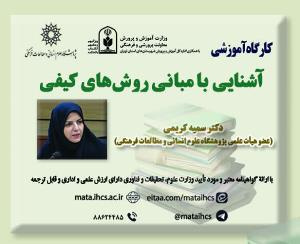ارائه الگوی مدیریت استعداد در دانشگاه علوم انتظامی امین (مقاله علمی وزارت علوم)
درجه علمی: نشریه علمی (وزارت علوم)
آرشیو
چکیده
زمینه و هدف: مدیریت استعداد مجموعه کاملى از فرایندها براى شناسایى، به کارگیرى و مدیریت افراد به منظور اجراى موفقیت آمیز استراتژى کسب و کار مورد نیاز سازمان است پژوهش حاضر با هدف ارائه الگوی مدیریت استعداد در دانشگاه علوم انتظامی امین می باشد. روش شناسی: تحقیق حاضر، از نظر هدف، کاربردی و از لحاظ رویکرد آمیخته است (کیفی و کمی) است. در این تحقیق از دو روش نمونه گیری استفاده شده است. در بخش اول خبرگان حوزه منابع انسانی به صورت هدفمند17 نفر و در بخش کمی 247 نفر به روش نمونه گیری تصادفی ساده انتخاب شده اند.ابزار گردآوری داده ها از طریق مصاحبه و پرسشنامه بوده است. روایی ابزار پرسشنامه با استفاده از روش محتوایی و نظر خبرگان و اساتید خبره ، و پایایی ابزار از طریق آلفای کرانباخ 93 درصد بوده است. به منظور تحلیل داده های کیفی از روش تحلیل محتوا و به منظور تحلیل داده های کمی با استفاده از آمار توصیفی و استنباطی تجزیه و تحلیل آماری با استفاده از نرم افزار آماری spss و Lisrel و مدلیابی معادلات ساختاری استفاده شده است. یافته ها: بر اساس مصاحبه با خبرگان و بررسی متون و تحلیل داده ها، نتایج نشان داد که مدل نهایی الگوی استعداد دارای5 مولفه، شناسایی، جذب، انتخاب، نگهداشت، توسعه و بکارگیری و 37 شاخص است. نتایج:الگوی مدیریت استعداد ارائه شده می تواند به مسئولین امر کمک کند تا به جای تکرار آنچه در مدیریت منابع انسانی انجام می شود، چارچوب منسجمی را برای کشف، توسعه، ارزیابی و نگهداشت سرمایه های انسانی ارزشمند پیش روی داشته باشند و بدین وسیله پاسخگوی چالش ها و نیازهای نوظهور باشند.Presentation of talent management model in Amin University of Police Sciences
Background and purpose: talent management is a complete set of processes for identifying, employing and managing people in order to successfully implement the business strategy needed by the organization. The research was conducted with the aim of presenting a model of talent management in Amin University of Police Sciences. Method: The research is applied in terms of purpose and in terms of mixed approach (qualitative and quantitative) and two sampling methods have been used. In the first part, 17 human resources experts were selected in a targeted manner and in the quantitative part 247 people were selected by simple random sampling method. The tools of data collection were interviews and questionnaires. The validity of the questionnaire tool using the content method and the opinion of experts and professors and the reliability of the tool through Cronbach's alpha was 93%. In order to analyze the qualitative data, the content analysis method was used, and in order to analyze the quantitative data using descriptive and inferential statistics, statistical analysis was used using SPSS and Lisrel statistical software and structural equation modeling. Findings: Based on interviews with experts and literature review and data analysis, the results showed that the final model of the talent model has five components, identification, attraction, selection, maintenance, development and application, and 37 indicators. Conclusion: The model of talent management can help officials to have a coherent framework for discovering, developing, evaluating and maintaining valuable human capital instead of repeating what is done in human resource management and thus respond to emerging challenges and needs.







